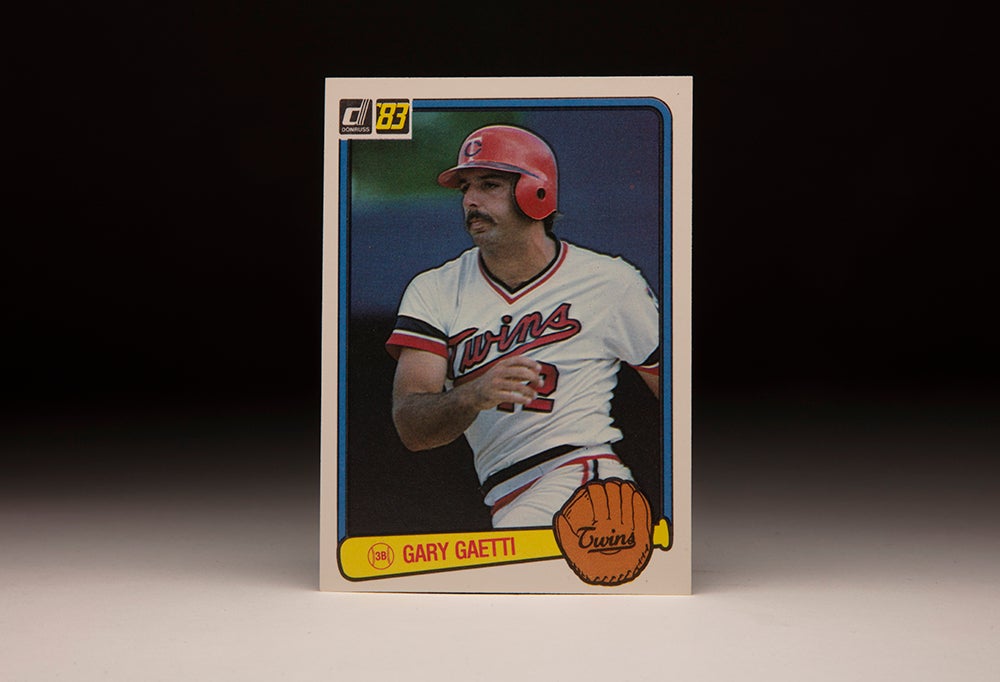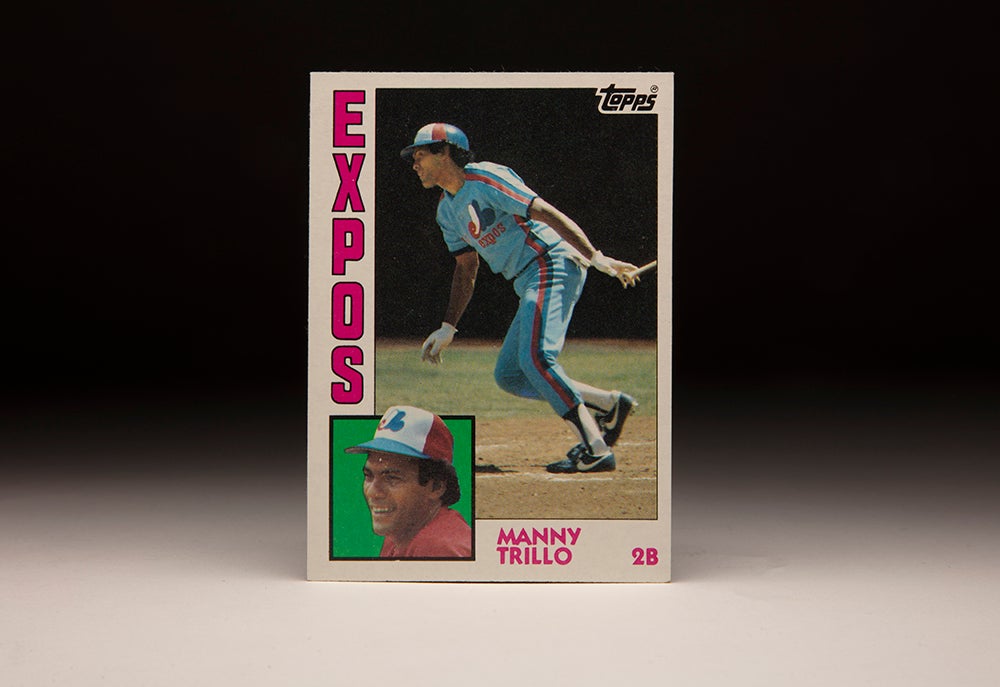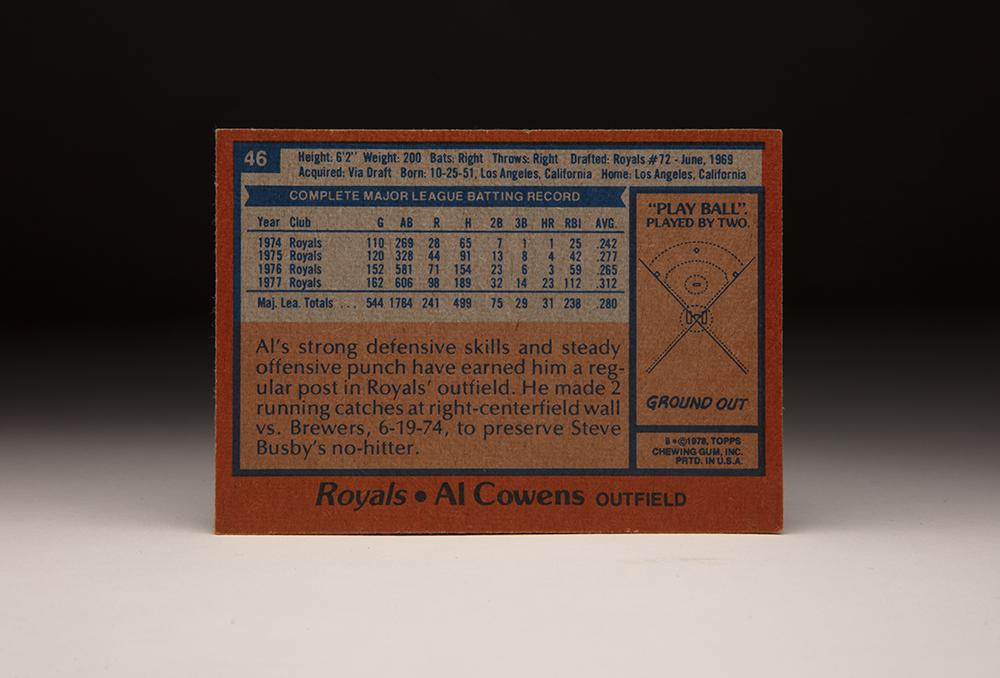- Home
- Our Stories
- #CardCorner: 1978 Topps Al Cowens
#CardCorner: 1978 Topps Al Cowens
In 1977, Rod Carew famously chased the .400 mark for much of the summer, landing on the cover of Time magazine and eventually winning the American League Most Valuable Player Award.
But despite Carew’s .388 batting average and 239 hits, he was not a runaway victor in the AL MVP race. Finishing in second place – just 56 points behind Carew – was Kansas City’s Al Cowens, a former 75th-round draft pick who became a shining example of the Royals’ thriving farm system.
Born Oct. 25, 1951, in Los Angeles, Cowens attended Centennial High School in Compton, Calif. In an era where teams could make unlimited draft picks, Cowens was selected in the 75th round of the June 1969 MLB Draft by the Royals.
By that time, only the Royals and the Expos – both of which debuted in the big leagues that same year – were still making selections, and the Expos stopped after the 76th round. Kansas City, meanwhile, continued to draft players through the 90th round.
Official Hall of Fame Merchandise
Hall of Fame Members receive 10% off and FREE standard shipping on all Hall of Fame online store purchases.
With all those players in the system, Cowens – and his teammates – had to do anything they could to stand out. He made his pro debut with Kingsport of the Appalachian League that summer, hitting .294 with 30 runs scored in 51 games. After some work in the Arizona Instructional League following the season, Cowens was assigned to Billings of the Pioneer League, where he hit .283 in 1970.
From there, Cowens – who had already made a name for himself with a strong arm and good footspeed – quickly advanced through the Royals’ system. He batted .285 with 18 steals and 71 RBI for two Class A teams in 1971, hit .256 with 65 RBI for three teams across two different levels in 1972 and spent all of 1973 with Jacksonville of the Southern League, where he hit .289 with 16 homers and 81 RBI while earning a starting berth in the SL All-Star Game.
“Cowens is one of the best prospects I’ve seen this year because he does a lot of things well,” Orlando Twins manager Harry Warner told the Orlando Sentinel. “He’s a strong hitter, he runs well and he has a heckuva arm.”
His performance at Jacksonville earned Cowens an invitation to Royals camp in 1974, and he quickly impressed manager Jack McKeon.
“I like what I’ve seen of his bat,” McKeon told the Associated Press. “I know it’s early, but he’s going to have to play himself off this team.”
On Opening Day, Cowens found himself on the Royals roster as a backup outfielder. He would not play in the minor leagues again.
Cowens hit .242 in 110 games in 1974, slugging just .286 as he adapted to big league pitching. The next season, the right-hand hitting Cowens began the year in a platoon role in right field with lefty-hitting veteran Vada Pinson. He then took over in center field for about three weeks starting in late June when Amos Otis was hurt before heading back to right field when Otis returned.
Cowens finished the year hitting .277 with four homers, 42 RBI and 12 stolen bases in 120 games.
During the 1975 season, Whitey Herzog replaced McKeon as the Royals’ manager – and Kansas City finished the year in second place in the AL West with a 91-71 mark. In 1976, Cowens became the Royals’ Opening Day right fielder – and Herzog led the team 90 victories and the division title, snapping Oakland’s five-year run atop the AL West.
Cowens batted .265 in 152 games that year. And though he hit just three home runs, he drove in 59 runs and scored 71 more while stealing 23 bases and finishing first among AL right fielders with 307 putouts.
In the American League Championship Series vs. the Yankees, the teams split the first four games as Cowens totaled three hits and two runs scored in 17 at-bats. Then in the deciding Game 5, Cowens – who played center field for virtually the entire series after Otis injured his foot in Game 1 – singled and scored on George Brett’s dramatic eighth-inning home run that tied the game at 6.
In the top of the ninth, Buck Martinez singled with two outs and Cowens followed with a walk, bringing up Jim Wolhford. With Brett on deck, Wolhford chopped the ball to the left side of the infield, where it was cut off by Yankees third baseman Graig Nettles.
Nettles went the short way to get the force at second base, and umpire Joe Brinkman called Cowens out on a close play where TV replays seemed to indicate Cowens had beaten the throw.
“I thought (Cowens) was safe,” Herzog told the Associated Press. “But I didn’t go out to argue cause I knew it wouldn’t have made a difference.
“It was a real important call. We wanted Brett to have a chance with the bases loaded.”
In the bottom of the ninth, Chris Chambliss led off with a home run, giving New York the pennant.
In 1977, Cowens and the Royals were determined to take the next step. For Cowens, that meant adding more power to his game. He tinkered with his stance in Spring Training of 1977 – with the help of hitting coach Charlie Lau – and became famous for his loose grip on the bat as he awaited each pitch, with the lumber nearly falling out of his hands.
“One day in Spring Training it just came to me when I was in the batting cage,” Cowens told the Kansas City Star in 1977. “I started dropping my bat down and that was it.
“Last year I got down in myself. I knew I could do better. This winter, I worked out every day with a group of other major leaguers and I was really ready when spring came.”
Cowens totaled four RBI in the Royals’ second game of the season and kept hitting from there, pushing his average above .300 with a 5-for-5 day against the Blue Jays on June 1. It did not dip below .295 the rest of the was as Cowens finished the year hitting .312 with 23 homers (tied with John Mayberry for the team lead) and 112 RBI (tops on the Royals) while hitting cleanup for most of the year.
“A lot of the fastballs I was hitting up the middle last year,” Cowens told the Kansas City Star, “I’m pulling now.”
The Royals won the AL West again and once again faced the Yankees in the ALCS. Another classic five-game series ensued, with Cowens going 3-for-4 with a home run in Kansas City’s 7-2 win in Game 1 while also robbing Mickey Rivers of a home run.
“If Al Cowens was in New York and his name was Reggie Jackson, he’d be most valuable player, walking,” Reggie Jackson told the Morning News of Wilmington, Del., after Game 1.
But Cowens went hitless in the next three games, with the Yankees winning twice. Then in Game 5, Cowens’ RBI groundout in the first inning scored George Brett to give Kansas City a 2-0 lead – and Cowens’ single in the third inning scored Hal McRae to put the Royals up 3-1. He added an infield single in the fifth inning, and Kansas City took a 3-2 lead into the ninth inning.
But the Yankees scored three times in the top of the ninth to take a 5-3 lead, and the Royals went down in order in the bottom of the inning as New York again advanced to the World Series.
On Nov. 16, Cowens learned that he finished second to Carew in the AL MVP vote. A week later, Cowens won a Gold Glove Award following a season where he led all AL right fielders with 14 assists.
“Personally, I think Al Cowens is the MVP in this league, taking nothing away from Carew,” Royals pitcher Paul Splittorff told the Herald Statesman of Yonkers, N.Y., during the ALCS. “Al Cowens got us here.”
Cowens and the Royals went into Spring Training of 1978 thinking that they were ready to win it all.
“Al’s the best defensive right fielder in the league right now,” Herzog told the News-Press in Fort Myers, Fla., in Spring Training of 1978.
But the power that Cowens found in 1977 deserted him in 1978 as he hit .274 with five home runs and 63 RBI in 132 games. The Royals won their third straight division title, but this time the Yankees needed just four games to dispatch Kansas City from the postseason. Cowens was 2-for-15 with two singles and an RBI in the series.
In 1979, Cowens hit .295 with nine homers and 73 RBI – impressive numbers considering he missed about three weeks of action after getting hit in the face by a pitch from the Rangers’ Ed Farmer on May 8. Earlier in the game, Farmer hit Kansas City second baseman Frank White, breaking White’s right hand.
“I think Frank is the best defensive second baseman in the game, and when it comes to right fielders, there’s not many who compare with Al,” Herzog told the Associated Press.
The injuries helped to derail the Royals’ season, and Kansas City finished with a record of 85-77, three games behind the Angels in the AL West.
On Dec. 6, 1979, the Royals sent Cowens, Todd Cruz and Craig Eaton to the Angels in exchange for Willie Aikens and Rance Mulliniks. “We have come up with one of the best power and RBI hitters in the majors,” new Royals manager Jim Frey told United Press International about Aikens. Cowens, meanwhile, joined an Angels team that already featured veteran outfielders Don Baylor, Dan Ford, Rick Miller and Joe Rudi. On May 27, 1980, the Angels eased that logjam by trading Cowens to the Tigers in exchange for first baseman Jason Thompson. Cowens hit .280 for the Tigers in 108 games that year, finishing the season with a combined .268 batting average, six homers and 59 RBI in 142 games while leading AL right fielders in fielding percentage with a .988 mark. But he made headlines with Ed Farmer again when – on June 20 – he charged the mound after hitting a grounder to shortstop against Farmer, who was now pitching for the White Sox. Cowens threw a punch at Farmer, triggering a brawl that later drew a warrant from Chicago police for Cowens’ arrest. Cowens was eventually suspended for seven games by American League president Lee MacPhail. “I know this matter has been on Cowens’ mind for a long, long time,” Tigers manager Sparky Anderson told the Associated Press. “Now, I hope it’s off his mind. Really, it’s no big deal.” Cowens and Farmer settled their differences later in the season, with the charges being dropped. In 1981, Cowens hit .261 as the Tigers’ regular center fielder – though he was often lifted when a right-hander was on the mound – but tallied only one homer and 18 RBI in 85 games. Then on March 28, 1982, the Tigers sold Cowens’ contract to the Seattle Mariners in exchange for a reported price of $60,000. Now in the final year of a contract that was paying him better than $200,000 annually, Cowens was revitalized in Seattle. After waking up on May 8 hitting just .181, Cowens finished with a .290 average over his final 118 games, totaling 20 homers and 78 RBI for the season while leading all AL right fielders with 14 assists. “Whatever happens at the end of the season just happens,” Cowens told the Associated Press of his impending free agency. “I can’t predict anything.” Cowens didn’t need a crystal ball, however, to know that his services would be in demand. After becoming a free agent, Cowens re-signed with the Mariners on a three-year deal worth a reported $1.2 million. “I still have to go out there and perform,” Cowens told the AP in Spring Training of 1983. “I still have to go out there and play.” But Cowens again endured a slow start in 1983 and was hitting .181 deep into July when he was sidelined for a month with tendinitis in his throwing shoulder. He finished the year hitting .205 with seven homers and 35 RBI in 110 games. Cowens bounced back in 1984 with a .277 average, 15 homers and 78 RBI, then hit .265 with 14 homers and 65 RBI the following season. But the Mariners went 74-88 in each of those years, and Seattle let Cowens become a free agent following the season. But the Mariners had second thoughts as Spring Training dawned and brought Cowens back on a one-year deal worth $360,000 on Feb. 7. Another slow start, however, saw Cowens batting .184 through May 7. The next day, the Mariners fired manager Chuck Cottier and replaced him with Dick Williams, a future Hall of Famer who was determined to inject youth into Seattle’s lineup. After 10 games playing for Williams, Cowens was released on June 12, ending his big league career. Cowens later scouted for the Royals before suffering a fatal heart attack on March 11, 2002, at the age of 50. Over 13 big league seasons, Cowens hit .270 with 1,494 hits, 276 doubles, 108 home runs and 120 stolen bases. And though he never again approached his fantastic 1977 numbers, Cowens left a legacy no one would have predicted for a 75th-round draft choice. “When I get on the field, I’m going to satisfy myself,” Cowens said during the 1977 ALCS. “And if I satisfy myself, I’m going to satisfy other people, too.”
Craig Muder is the director of communications for the National Baseball Hall of Fame and Museum
Related Stories

#CardCorner: 1983 Donruss Gary Gaetti

#CardCorner: 1984 Topps Manny Trillo

#CardCorner: 1986 Fleer Al Holland

#CardCorner: 1983 Donruss Fred Lynn

#CardCorner: 1983 Donruss Gary Gaetti

#CardCorner: 1984 Topps Manny Trillo

#CardCorner: 1986 Fleer Al Holland








